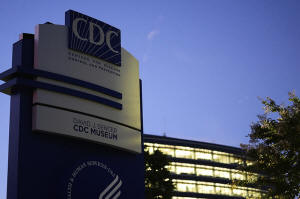With CDC in chaos, scientists and physicians piece together replacements
for agency's lost work
[August 30, 2025]
By MIKE STOBBE
NEW YORK (AP) — The CDC is in chaos and some groups are starting to step
in and take over work the agency was doing.
The moves come in response to Health Secretary Robert F. Kennedy Jr.'s
extensive — and some say illegal — restructuring and downsizing of the
Atlanta-based Centers for Disease Control and Prevention.
Many public health veterans see an agency wracked by a leadership
crisis, staff cuts, budget cuts and unprecedented levels of political
meddling. The concern hit a crescendo when the White House moved to oust
the agency's director and some top CDC leaders resigned in protest.
But even before CDC Director Susan Monarez was fired, some organizations
started pursuing new ways to do jobs formerly handled by the CDC.
Some are working to preserve longstanding vaccination recommendations.
Some are trying to release information that CDC has stopped providing.
Others aim to maintain health data collections at risk of being lost.
But these outside efforts don't have the federal funding, resources,
legal mechanisms or platform that have been the underpinning of the
nation's public health system. As noble as they are, these patchwork
efforts probably won't cut it, some experts say.
“There may be some workarounds,” said Dr. Megan Ranney, dean of the Yale
School of Public Health. “But I'm not sure it's fair or appropriate that
people feel like they have to turn to private groups instead of the
government.”
Vaccination guidance tops the list
For decades, the CDC has set the nation’s standards on vaccines — which
ones are recommended and who should get them.

The recommendations were guidance, not law. But they were automatically
adopted by doctors, school systems, health insurers and others.
They were the result of a lengthy data review process involving a panel
of outside experts, the Advisory Committee on Immunization Practices.
But in May, Kennedy — a longtime leader in the anti-vaccine movement —
announced COVID-19 vaccines would no longer be recommended for healthy
children and pregnant women. He made the decision without input from the
ACIP.
In June, he abruptly dismissed the entire panel, accusing them of being
too closely aligned with manufacturers. He replaced them with a
handpicked group that included several vaccine skeptics, and then shut
the door to several doctors groups that had long helped form ACIP
recommendations.
It’s not clear what other changes are in store for ACIP, but a number of
medical groups say Kennedy can’t be counted on to make decisions based
on robust medical evidence.
The moves sparked a group of public health researchers and others to
form the Vaccine Integrity Project, based at the University of
Minnesota, which aims to become the kind of compiler and reporter of
medical evidence that the CDC and ACIP have been in the past.
A committee meeting without CDC
In mid-August, the group held an ACIP-like Zoom meeting, in which
subject-matter experts presented lengthy reviews of recent research
about the safety and effectiveness of COVID-19, flu and RSV vaccines for
children, pregnant women and people with weakened immune systems.
It also featured a four-person panel of experts, including the
editor-in-chief of the New England Journal of Medicine. Like ACIP
members, they asked presenters questions about their analyses.
Presenters made clear that they had to base their presentations on what
had appeared in medical journals and was publicly available; they
weren’t privy to unpublished surveillance and safety data that CDC
collects.
The group is not making vaccination recommendations itself. But it is
working with doctors organizations that are. One is the American College
of Obstetricians and Gynecologists, which has said pregnant women should
continue to get COVID-19 shots — counter to what Kennedy announced.
Another is the American Academy of Pediatrics continuing to recommend
them for children ages 6 months to 2 years.
But as medical societies split from CDC, it’s not yet clear which
recommendations insurers will heed when making coverage decisions. And
there remain a number of other questions, such as: What will happen in
states that have vaccination policies tied to ACIP recommendations?

[to top of second column]
|

A sign marks the entrance to the U.S. Centers for Disease Control
and Prevention headquarters in Atlanta, on Wednesday, Aug. 27, 2025.
(AP Photo/Brynn Anderson)
 In Massachusetts, Democratic Gov.
Maura Healey included language in a $2.45 billion supplemental
budget bill that gives the health department authority to set its
own recommendations and requirements if the federal government
“fails to maintain a robust schedule of vaccine recommendations.”
Some other efforts now underway:
Vaccine finders
During the COVID-19 pandemic, the CDC teamed up with researchers at
Boston Children’s Hospital and Harvard Medical School on
www.vaccines.gov. The website told about newly developed vaccines
recommended to protect against the coronavirus and served as a
search engine to help people find nearby pharmacies that had the
shots in stock.
But the site gradually dropped information about vaccines and why
they were recommended, and this year became a stripped-down version
that simply said: “Find a pharmacy near you” and a box to type in
your zip code. When the government's contract with Boston Children's
Hospital ended in late July, the site stopped working altogether.
Researchers at Boston Children's Hospital this month restarted a
version of the site that existed before the pandemic,
www.vaccinefinder.org.
“We're turning back to what it was,” said John Brownstein of Boston
Children's, who founded the site. “Obviously, as a (government) site
it carries more weight. But if that isn’t in the cards, we’re very
happy to carry the torch.”
Dental safety
Last month, the Association for Dental Safety launched a new
institute for dental safety that was designed to pick up some of the
work done by the CDC’s Division of Oral Health, which was eliminated
in the spring. The new institute is first focused on updating
infection controls guidelines for dental offices, which the CDC last
updated in 2003.
“Without a doubt, ADS is the best choice to continue oversight of
dental infection prevention and control guidelines, ensuring
recommendations are current, scientifically sound, translated into
lay terms and disseminated to those who need them on a daily basis,”
said Nicole Johnson, former associate director in the CDC’s Division
of Oral Health, in a press statement.
Pregnancy data
The CDC's Pregnancy Risk Assessment Monitoring System, which
annually surveys women across the country, lost its entire staff —
about 20 people — in layoffs this year. It was the most
comprehensive collection of data on the health behaviors and
outcomes before, during and after childbirth. Researchers have been
using its data to investigate the nation’s maternal mortality
problem.

Some states that have the money and motivation might decide to run
similar surveys, just within their borders. California runs its own,
PRAMS-like survey.
But “if states are doing their own thing, then we don't have
national, comparable data across jurisdictions and across time,”
meaning its not possible to see where problems are most severe and
which policies to reduce maternal deaths are working, said Jamie Daw,
a Columbia University health policy researcher focused on pregnancy.
Violence prevention
Kennedy recently fired about 100 CDC staffers who provided training,
education, and advice to state and local violence prevention
programs, and evaluate how well they were working.
“What's the point in knowing the about the rates of violence if
you're not going to do anything about it?” said Sarah DeGue, one of
the laid-off CDC researchers.
But existing programs still need technical guidance and expertise.
In May, DeGue founded Violence Prevention Solutions, a consulting
firm, to help community organizations develop and evaluate programs.
“It's us trying to rebuild what we had somewhere else, in a
different way, so that all the knowledge and experience and
resources that we had can still be available,” she said.
___
AP reporter Michael Casey in Boston contributed.
All contents © copyright 2025 Associated Press. All rights reserved |